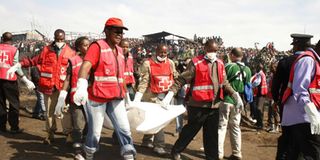The 2011 Sinai fire evokes nightmarish memories

Rescuers remove bodies from the scene of the Sinai fire tragedy. FILE | NATION MEDIA GROUP
At around three o’clock, I received a call from the burns unit. The nurse introduced herself as Daisy* and asked me to pass by when I had a moment to review a patient. I thought she was mistaken. We catered to pregnant women and to gynaecological patients. I was confident we had no business in the burns unit. The nurse listened to my protests and calmly repeated her request to review a patient in the unit who had survived the explosion and was pregnant. I immediately went cold.
I am absolutely terrified of burns patients. I was then, I still am to date. For this mother to have been admitted to the burns unit, it meant her burns were major. Throughout my internship year in the same institution and even then as a registrar, I had never entered the burns unit. I walked right past on my way to the critical care unit hundreds of times, but I always looked away from the entrance. Now I had to conquer my fear and drag my unwilling feet through the door. My unfamiliarity with the unit was obvious. I had to don protective gear to prevent spreading infection to the patients.
I was struck by how clean the whole unit was. However, the sparkling floors, the clean walls and the bright lights could not eliminate the smell of roasted, rotting flesh. I was overwhelmed and several times I had to walk out to get some fresh air. I made my way to the nursing desk and met Daisy.
Daisy handed me the patient’s file. Charity* was 31 years old and was pregnant with her third baby. She was asleep in the house when the explosion happened and she never had a chance to escape as her house was very close to a large trench that had gotten contaminated. She was wheeled in to the emergency department unconscious.
Her assessment revealed she had suffered approximately 80 per cent burns and she had spent all morning in the operating room while the surgeons fought to keep her alive. They excised off all scar tissue that could lead to constriction of the chest wall, hindering her breathing. She was brought to the ward intubated and was hooked onto a ventilator as part of her airways were markedly inflamed and swollen, threatening to close off her airway.
KIDNEY FAILURE
As she lay there with her chest and abdomen rising with every breath, it had been confirmed that her baby was already deceased at 35 weeks of pregnancy. The surgeons wanted her delivered of the baby as fast as possible to give Charity a fighting chance. I could not examine her as there was nowhere to touch. Her whole body was raw with no skin left intact on the frontal aspect. It was heavily covered in silver sulfadiazine, a cream to keep it moist and keep out infection. The room was extremely warm to prevent hypothermia, now that there was no skin to regulate the temperature.
I walked away in a daze and prescribed medication that we would use to induce her labour and start the process of expelling the baby out of its mother. I was so devastated I did not realise I was talking to myself on the way to my safe place in the car. I could not get rid of the stench in my nose and the matter-of-fact response from Daisy upon inquiring how they survived the long shifts amid the smell. She calmly told me that one adjusted to it the way a pregnant woman adjusted to morning sickness.
I was back to the ward in an hour to do the insertion of my prescription drug vaginally. She moaned throughout, in deep agony that could not be verbalised through her endotracheal tube.
I walked away depressed. I was going home knowing that although my colleague would refresh the prescription after 12 hours, I was going to be the one conducting the actual delivery the next day. I had nightmares about it all night.
It was not to be. Charity gave up the fight at 7.30 the next morning as I walked in to check on her before starting rounds. She thought it wise to join her baby in heaven. For the hell she was going through, it was a decision we all grudgingly agreed with. Even if she had survived the burns, she would have remained in hospital for months as she weathered infections, possible kidney failure with dialysis and multiple surgeries and skin grafts in an attempt to give her back a semblance of normalcy. She would have endured hours of gruelling physiotherapy and occupational therapy to be able to function again and there is no guarantee her sight would have survived.
I respect the nurses who work in the burns unit with unparalleled passion and dedication and a dysfunctional sense of smell.
Dr Bosire is an obstetrician/gynaecologist



